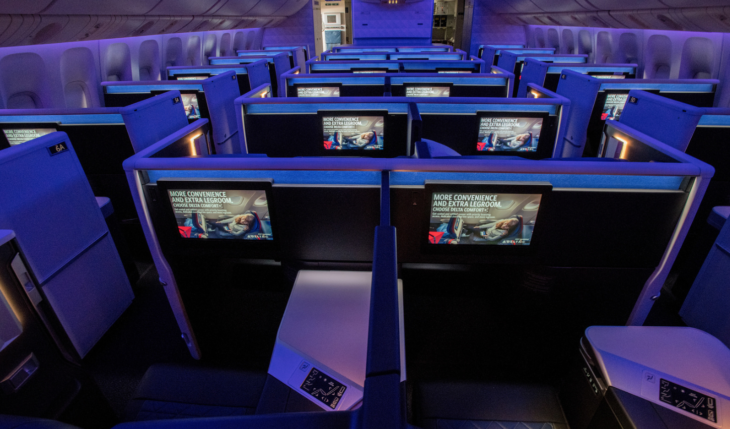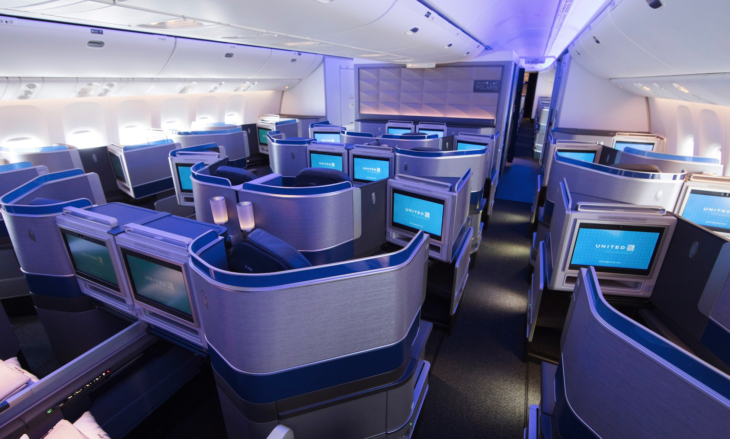In the United States, there are three large airlines with a long history of continuous operations, extensive fleets, and expansive domestic and international routes, commonly called legacy carriers, which include United Airlines, American Airlines, and Delta Air Lines.
Throughout commercial aviation history in America, there has been dozens of brands that over the years have merged or ceased operations.

American Airlines
Today, American Airlines is the largest US airline when measured by number of passengers annually with over 198 million passengers in 2017. With hubs in Charlotte (CLT), Chicago O’Hare (ORD), Dallas (DFW), Los Angeles (LAX), Phoenix (PHX), Miami (MIA), Philadelphia (PHL), and New York (JFK), the airline flies to over 350 destinations around the world.
As a member of the OneWorld alliance, travelers can seamless connect to any city in the world on a partner airline with easy. The airline is aimless for one of the youngest fleets in the industry and buying a large number of new planes that are more modern, efficient, and comfortable.
Currently they have over 20 different plane variants in their fleet including the Boeing 787, 777, 767, 757, 737, Airbus A330, A321, A320, A319 as well as the regional planes ERJ 140, 145, 175, 190, CRJ 200, 700, 900 and even a few Dash-8 and MD-80s. American Airlines still operates a international first class on their 777-300ER and has begun adding a true premium economy cabin on new and retrofit planes used for long-haul service.
Passengers flying in premium cabins on international flights are invited to use the Flagship lounges located at select airports and the airline operates a large number of Admiral Club lounges throughout the US for domestic flights. Over the years the airline has merged with several others, most recent being US Airways in 2013.

Delta Air Lines
The second largest US airline by passenger capacity belongs to Delta with approximately 186 million passengers for 2017. The airline’s headquarters and largest operations are in Atlanta (ATL), but they have numerous hubs throughout the US in Detroit (DTW), Los Angeles (LAX), Minneapolis (MSP), Seattle (SEA), Salt Lake City (SLC), and New York (JFK and LGA).
With over 320 destinations, ownership stake in both Virgin Atlantic and AeroMexico, and a member of the SkyTeam alliance, passengers have access to almost any major destination around the world. Delta’s has used many different approaches to operations throughout the years including purchasing an oil refinery as well as retrofitting older aircraft to stay competitive in the industry.
They have an large fleet consisting of Boeing 777, 767, 757, 737, and Airbus A350, A330, A321, A320, and MD-80/88’s as well as CRJ 100, 200, 700, 900, and the ERJ 170, 175. Like American Airlines, Delta is updating its fleet and is the first US carrier to use the Airbus A350 which features Delta One Suites.
Delta is also adding a true premium economy cabin called Premium Select to new and retrofitted international planes, but doesn’t operate an international first class product on any aircraft. Unlike the other two airlines, Delta only has one lounge offering called the Sky Club with outdoor seating on the SkyDeck at their New York (JFK) and Atlanta (ATL) signature Sky Clubs. Like other US airlines, Delta contains the past of several past airlines including Northwest Airlines in 2008.

United Airlines
United Airlines is the third largest US airline when measured by annual revenue with almost 38 billion dollars in 2017. Spread out across the United States, United Airlines has 8 hubs including Chicago (ORD), Denver (DEN), Houston (IAH), Los Angeles (LAX), San Francisco (SFO), Washington (IAD), Newark (EWR), and even Guam (GUM). The airline flies to over 340 destinations around the globe an as a founding member of the Star Alliance, allows travelers the ability to reach 6 continents on a direct flight.
A few years back, the airline announced a notable improvement to its premium classes with a product and service called Polaris, although with plans to phase out an international first-class cabin. The airline was the first to operate the Boeing 787 in the United States, and has many different models of aircraft in it’s fleet including the Boeing 777, 767. 757, and 737 as well as the Airbus A320 and A319. Its regional aircraft include the ERJ 175, 170, 145, 135 and CRJ 200, 700, as well as several turbo props.
United Airlines is well underway with installing Polaris business class seats on their existing widebody international fleet, but doesn’t have any true premium economy on any aircraft at the moment. With the introduction of the Polaris seats, also came the launch of the Polaris Lounge for premium cabin passengers on international flights. This lounge is designed to provide a more upscale experience over their United Club lounge which are located throughout the United States and some international airports. United Airlines is also a combination of previous airlines with the last merger happening in 2010 with Continental Airlines.
Each airline has benefits and unique attributes that allows them all to operate concurrently. From different strategies with product and service offerings to focus regions and operational capabilities, no airline does everything perfect. Depending on your flying patterns, where you are going, and what level of service you desire all play a factor in evaluating which airline will best serve a passenger.

Leave a Reply